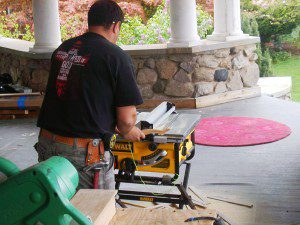5 Safety Tips For Managing Construction During a Rainy Season
October marks the start of the wet season in the United States, lasting until around February. While it isn’t the best time to launch a home improvement project, sometimes, there is no better time than now. Your house could be having some real problems like a leaking roof, cracked foundation, or poor ventilationVentilation is the process of exchanging or circulating air ... More. Waiting until summer could make the situation worse, leading to higher costs. Furthermore, your business shouldn’t stop. Actually, more homeowners require repairRepair is the act of fixing or restoring damaged property, m... More and construction services during the wet season because it’s during such time when they usually uncover problems with their homes.
You can make it through the rain, so a line in a song goes. But to maintain the efficiency of your home improvement project, here are five important tips to consider:
Prioritize everyone’s safety

Construction and remodeling
Workers’ safety should be the number one concern in all types of home construction services and projects, regardless of the weather condition. But during the rainy season, the risk of slip and fall is far worse, as snow and ice can make roofs, walkways, roads and floors slippery.
Additionally, it is important to monitor the wind chill temperature, as some workers may not be physically fit to work in the cold. If the weather is severely bad (such as in the case of a hurricane or storm), it is expedient to stop work immediately. Otherwise, the following work safety measures should be observed:
- Wear protective gears and visibility clothing, including raincoat, boots and gloves that have slip-proof grip.
- Equipment that requires electricity to run should be placed and used indoors.
- Use proper tools and equipment. Never use electrical tools that are not specifically rated for outdoor use.
- During thunderstorms, be extra cautious of exposed steel structures are high conductors of electricity.
- Always follow OSHA’s construction safety standards regardless of the weather conditions.
Plan ahead
 PreparationPreparation is the steps taken to ready a property, equipmen... More and planning are the key to a successful construction project especially during the wet season when there’s more risk of accidents and work delays. It is important to prepare all supplies and equipment that will be used so as to ensure a smooth and steady workflow. Consider placing protective sheets in the scaffolding and remove loose items that can fall and injure anyone. Be sure to constantly update yourself and your crew about the latest weather forecast.
PreparationPreparation is the steps taken to ready a property, equipmen... More and planning are the key to a successful construction project especially during the wet season when there’s more risk of accidents and work delays. It is important to prepare all supplies and equipment that will be used so as to ensure a smooth and steady workflow. Consider placing protective sheets in the scaffolding and remove loose items that can fall and injure anyone. Be sure to constantly update yourself and your crew about the latest weather forecast.
Protect Equipment and the Jobsite from Rain
Working under the rain is already inconvenient. Thus, you want to take measures to at least reduce the amount of water entering the job site and potentially damaging your equipment. An effective and inexpensive measure is to make use of waterproof tarps. You can install a temporary shed for your workers when they have to do some tasks outdoors. Tarps also make a good cover for construction equipment and supplies. Choose high-quality tarps with grommets for easy set-up and installation.
Practice caution when working with concrete
The key to building a home during bad weather is to get the foundation installed and the house up out of the ground before extended periods of rain or snow starts. It is fine to pour concrete in cold weather, but the whole process requires an experienced crew and the proper equipment. Before placing concrete on footings, remove water that may have pooled. If the rain is so heavy that rain puddles cannot be removed, it is recommended to suspend concrete pouring until at a later time.
Use the right tools and materials
Investing on the latest building materials can be advantageous for contractors as most of them are water-resistant. For example, new roof sheathing has waterproof coating while oriented strand board (OSB) is sealed with a special tape that keeps just about all water out from the wood substrate. During long durations of rain or snow, it can be a good idea to install a temporary construction shed or site where your crew can work freely and comfortably. The sides can be covered with tarps for added security and protection from rain, snow and wind.
Home reconstruction services are possible even during the wet season. However, advanced planning and preparationPreparation is the steps taken to ready a property, equipmen... More, as well as extra precaution is necessary. It takes an experienced team of contractors and the right tools and equipment to successfully facilitate a construction project when the weather is bad. Nevertheless, injuries and accidents are very likely. Thus, adhering to workers’ safety guidelines and observing these tips are of great importance.












